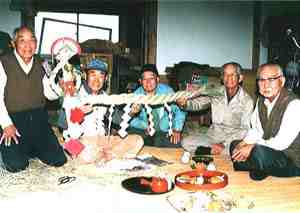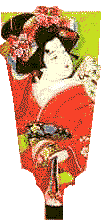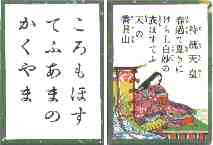to Japanese Edition
| Before New Year, people have a lot of tasks to do if they want to celebrate traditional New Year. On New Year day, the god named Toshigami-sama (direct translation is god of year sama is added to a name of person to express politeness.) comes to us. Therefore, for welcoming him the front door have to be decorated with ShimeNawa. Here to the left is shown a Shimenawa just finished crafting by aged people in Miho village.*1 | |

Kadomatsu*2 | 
Kagamimochi*3The gates have to be decorated with Kadomatsu and inner the house, KagamiMochi have to be dedicated to the Toshigami-sama (Rice Dumpling. see Moon Viewing).
Thus people pray for the rich harvest to Toshigami-sama who controls the harvest. These are all tasks of males. Nowadays these are sold at supermarket. |  | |
| Females prepare Osechi foods sufficient for New Year first three days so that no cooking is necessary these three days. Osechi foods are beautifully arranged in a lacquer ware called Jyuhbako or O-jyuh (this O is for politeness and jyuh is the abbreviation of Jyuhbako which means pilable box. Cooking Osechi is a hard work. Nowadays, sets of Osechi are sold in super-market. |  | The Typical plays of girls in New Year is Hagoita and Karuta. Hogoitas are used as racket of badminton of course using backside of Hagoita. The shuttle called as hane is made from a kind of nut and beautiful feather of birds.*4
Karuta is a set of cards combining 100 sets of ancient 31 syllables japanese poem and its author.*5. | |

Typical plays of boys in New Year days are koma (spin> spinning and tako (kite) flying. | | |  The cards shown are the set of 31 syllables japanese poet and its author Jitoh the female emperor. In ancient time, we had female emperors. The cards shown are the set of 31 syllables japanese poet and its author Jitoh the female emperor. In ancient time, we had female emperors. | |
| #1: | This picture is brought from following URL. The link was broken (04/Feb/17) http://www.joyoliving.co.jp/1997/1122/gantan.html
| | *2: | This picture of Kadomatsu is brought from following URL. The link was broken (04/Feb/17) http://www.hellonet.or.jp/~joa/shogatu/ensyu/ensyu1.html
|
| *3: | This picture of Kagamimochi is brought from following URL. There you will find more pictures. |
| *4: | This picture of Hagoita is brought from following URL. There you will find more pictures. |
| *5: | Karuta cards are consisted of 100 Yomifuda (cards to be read) containing full 31 syllables of japanese short poem and the portrait of its author, and 100 Torifuda (cards to be got) containing latter 14 syllables of the poem. Torifudas are scattered randomly on the floor. Then a Yomite (reader or singer) read the poems with particular melody for short poem. Players get the Torifuda by grasping the card read by reader faster than other players. Players must memorize the place of each scattered card and full 31 syllable of poem if they want to win. It is a game of memorizing ability and speediness. In New Year, Karuta championship is held. In older days, this Karuta gave a chance of playing boys and girls together while usually boys and girls never play together giving chance of touching a hand of girl. They were taught that males and females should not take seat together from the age of three years old, probably the custom introduced from China. |
|